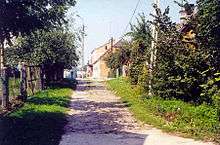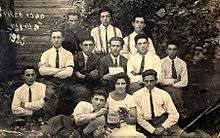Wizna
| Wizna | |
|---|---|
| Village | |
|
Saint John the Baptist church of Wizna | |
 Wizna | |
| Coordinates: 53°12′N 22°23′E / 53.200°N 22.383°E | |
| Country |
|
| Voivodeship | Podlaskie |
| County | Łomża County |
| Gmina | Wizna |
| Population | 1,300 |
| Website | http://www.wizna.pl/ |
Wizna [ˈvizna] is a village in Łomża County of Podlaskie Voivodeship, in north-eastern Poland. The Biebrza River flows through town. Wizna is also known for the battle of Wizna which took place in its vicinity during the 1939 Invasion of Poland.[1] At present, farming and food production are the primary sources of income for the residents. The food production by private farms provides favorable conditions for the development of processing industry.
Wizna has a remarkably rich history. Already in the 11th century there was a castle there watching over the eastern border of Masovia and the important river crossing over Narew. From the mid 12th century the town was a registered office of the castellany, and from 1379 the capital of the Ziemia wiska (Wizna Land) bordering both Prussia and Lithuania. The Catholic Parish in Wizna was established in 1390.[2]
History
Wizna was built on an important trade route from Lithuania to Kraków. Co-ruler of Poland Anna the Jagiellonian used to travel through town and so did Queen Bona Sforza. In the years 1435 - 1870, for over four centuries, Wizna was one of the most important cities of northern Masovia. Its significance began to drop only with the development of the town of Łomża. In 1860 Wizna had 2,573 residents. In the interwar period the population numbers rose to over 3,300 partly due to influx of new Jewish immigrants from the neighboring states.
The Jews in Wizna

It is not clear when Jews started to settle in Wizna. Most of the Jewish population lived around the Rynek (Town Square) and the nearby streets. In 1765, 16 Jewish families (about 75 individuals) lived in Wizna. In 1857, there were 492 Jews out of a total population of 1861; in 1921, they numbered 714 out of 2670. Jews were mostly small merchants, craftsman and service providers. In the small village of Witkowo, on the Narew River adjacent to the north side of Wizna, a few Jewish families were farmers and fishermen. These included the Gostkowski family, which operated a ferry on the Narew River for over 100 years prior to the construction of the bridge on the road between Łomża and Bialystok. The gangster-turned-author Urke Nachalnik was born in Wizna to the wealthy and respected Farberowicz family, who were grain merchants and operated a flour mill. Urke Nachalnik’s books and stories were published in several languages by the Yiddish press in Poland and in the United States during the 1930s, with some of them being turned into stage plays.
Emigration and Zionist activity in Wizna


Zionist parties were active in Wizna during the 1920s and 1930s. A Hebrew school called Tarbut was opened, and the Zionist youth movements Hashomer Hatzair and Hachalutz were active among the young Jewish generation. Jews from Wizna emigrated to the USA and other countries such as Cuba, Argentina and Australia during the Russian imperial rule in the 19th century and up until the onset of World War II. Groups of members of the Zionist youth movements emigrated to what was to become Israel before World War II and joined groups that founded the Kibutzim: Ramat-Hakovesh, Einat, Yagur, Giveat-Hashlosha, Kfar-Menachem, Ifat, Evron and Gvat. In addition former Wizners settled in Rishon-le-Zion, Tel-Aviv, Haifa, Jerusalem, Kfar-Saba, Kfar-Sirkin, Kiryat-Chaim, Petach-Tikva, Ramat-Gan, Holon, Ganei-Hadar, Ramat-Zvi, Nahariya, Tel-Mond and elsewhere.
World War II

Wizna is known as the Polish Thermopylae. It was a place of the Battle of Wizna (September 7–10, 1939) during the initial stages of the German Invasion of Poland. The Polish defense force consisted of approximately 700 soldiers and 20 officers armed with 6 pieces of heavy artillery. They held a fortified territory against a vastly larger invading force at great cost of lives, before being annihilated with no known survivors.[3] Heavy German assault on Polish bunkers continued for three days and was successfully repelled until the early morning of September 10. The German engineers with the help of tanks and explosives managed to destroy all but two Polish bunkers. Both of them were located in the centre of Góra Strękowa, and despite having much of the crew wounded or incapacitated and most of the machine guns destroyed continued their resistance till the end. It is said that General Heinz Guderian threatened the Polish commander, Captain Władysław Raginis, that he would shoot the POWs if the remaining force did not surrender. The symbol of Polish will, Władysław Raginis, committed honorable suicide by throwing himself on a grenade. German losses are not known. In his diaries Heinz Guderian noted that 900 German soldiers were killed in action, although that number is probably underrated. It is certain, however, that the Wehrmacht lost at least 10 tanks and several other AFVs in the struggle.[4]
Wizna Jews during the Holocaust
During the attack on the Soviet Union by Nazi Germany in 1941, Wizna was shelled and most of the homes in the Rynek and its vicinity were demolished. Some 30 Jews were killed. In July 1941, most Jews were deported by the Nazis to a much larger ghetto in Łomża and confined there until November 1942, before being shipped to Auschwitz together with the Jews from all surrounding villages and towns. Those who escaped to nearby Jedwabne were subsequently exterminated along with 340 Jews during the Jedwabne pogrom. According to Institute of National Remembrance, the crime was committed by Polish inhabitants of Jedwabne under the guns of Nazi German Ordnungspolizei.[5] The involvement of the German Einsatzkommando under SS-Obersturmführer Hermann Schaper deployed in Bezirk Bialystok specifically for that purpose, remains most likely.[6]
See also
Notes and references
- ↑ (Polish) Wizna, Gminne Centrum Informacji (official website)
- ↑ (Polish) Gmina Wizna - Informacje o regionie
- ↑ (Polish) A. Zawilski: Bitwy polskiego września, Kraków 2009, s. 209. Also: Kampania Wrześniowa 1939. "Bój pod Wizną"
- ↑ (Polish) Zygmunt Kosztyła, Obrona odcinka "Wizna" 1939, BKD (Bitwy, Kampanie, Dowódcy) [7/76], 1976. Also: P. Kupidura, M. Zahor, "Wizna", Wojskowy Przegląd Techniczny i Logistyczny, nr 3, 1999
- ↑ (Polish) The 90th session of the Senate of the Republic of Poland. Stenograph, part 2.2. A Report by Leon Kieres, president of the Institute of National Remembrance, for the period from July 1, 2000 to June 30, 2001. Donald Tusk presiding.
- ↑ (Polish) Thomas Urban, "Poszukiwany Hermann Schaper" (WANTED: Hermann Schaper). Rzeczpospolita, 01.09.01 Nr 204. (Polish)
- Wizna Web Page by Jose Gutstein
- Urke Nachalnik Famous Polish gangster, turned noted author was born in Wizna
- Facts about Polish Thermopylae at www.britannica.com
![]() Media related to Wizna at Wikimedia Commons
Media related to Wizna at Wikimedia Commons
Coordinates: 53°12′N 22°23′E / 53.200°N 22.383°E
